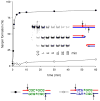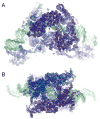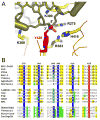An interlocked dimer of the protelomerase TelK distorts DNA structure for the formation of hairpin telomeres
- PMID: 17889664
- PMCID: PMC2041798
- DOI: 10.1016/j.molcel.2007.07.026
An interlocked dimer of the protelomerase TelK distorts DNA structure for the formation of hairpin telomeres
Abstract
The termini of linear chromosomes are protected by specialized DNA structures known as telomeres that also facilitate the complete replication of DNA ends. The simplest type of telomere is a covalently closed DNA hairpin structure found in linear chromosomes of prokaryotes and viruses. Bidirectional replication of a chromosome with hairpin telomeres produces a catenated circular dimer that is subsequently resolved into unit-length chromosomes by a dedicated DNA cleavage-rejoining enzyme known as a hairpin telomere resolvase (protelomerase). Here we report a crystal structure of the protelomerase TelK from Klebsiella oxytoca phage varphiKO2, in complex with the palindromic target DNA. The structure shows the TelK dimer destabilizes base pairing interactions to promote the refolding of cleaved DNA ends into two hairpin ends. We propose that the hairpinning reaction is made effectively irreversible by a unique protein-induced distortion of the DNA substrate that prevents religation of the cleaved DNA substrate.
Figures







Similar articles
-
Conversion of linear DNA with hairpin telomeres into a circular molecule in the course of phage N15 lytic replication.J Mol Biol. 2009 Aug 14;391(2):261-8. doi: 10.1016/j.jmb.2009.06.021. Epub 2009 Jun 10. J Mol Biol. 2009. PMID: 19523475
-
The protelomerase of the phage-plasmid N15 is responsible for its maintenance in linear form.J Mol Biol. 2001 Oct 5;312(5):899-906. doi: 10.1006/jmbi.2001.5019. J Mol Biol. 2001. PMID: 11580235
-
Phage N15 telomere resolution. Target requirements for recognition and processing by the protelomerase.J Biol Chem. 2002 Mar 22;277(12):10410-9. doi: 10.1074/jbc.M111769200. Epub 2002 Jan 11. J Biol Chem. 2002. PMID: 11788606
-
Mechanisms of replication and telomere resolution of the linear plasmid prophage N15.FEMS Microbiol Lett. 2003 Apr 11;221(1):1-6. doi: 10.1016/S0378-1097(03)00125-3. FEMS Microbiol Lett. 2003. PMID: 12694903 Review.
-
The plasmid prophage N15: a linear DNA with covalently closed ends.Mol Microbiol. 1999 Sep;33(5):895-903. doi: 10.1046/j.1365-2958.1999.01533.x. Mol Microbiol. 1999. PMID: 10476025 Review.
Cited by
-
ALOG domains: provenance of plant homeotic and developmental regulators from the DNA-binding domain of a novel class of DIRS1-type retroposons.Biol Direct. 2012 Nov 12;7:39. doi: 10.1186/1745-6150-7-39. Biol Direct. 2012. PMID: 23146749 Free PMC article.
-
The N-terminal domain of the Agrobacterium tumefaciens telomere resolvase, TelA, regulates its DNA cleavage and rejoining activities.J Biol Chem. 2022 May;298(5):101951. doi: 10.1016/j.jbc.2022.101951. Epub 2022 Apr 18. J Biol Chem. 2022. PMID: 35447111 Free PMC article.
-
An enzyme-catalyzed multistep DNA refolding mechanism in hairpin telomere formation.PLoS Biol. 2013;11(1):e1001472. doi: 10.1371/journal.pbio.1001472. Epub 2013 Jan 29. PLoS Biol. 2013. PMID: 23382649 Free PMC article.
-
Control of directionality in the DNA strand-exchange reaction catalysed by the tyrosine recombinase TnpI.Nucleic Acids Res. 2010 Apr;38(6):2044-56. doi: 10.1093/nar/gkp1187. Epub 2009 Dec 30. Nucleic Acids Res. 2010. PMID: 20044348 Free PMC article.
-
Transposase-DNA Complex Structures Reveal Mechanisms for Conjugative Transposition of Antibiotic Resistance.Cell. 2018 Mar 22;173(1):208-220.e20. doi: 10.1016/j.cell.2018.02.032. Epub 2018 Mar 15. Cell. 2018. PMID: 29551265 Free PMC article.
References
Publication types
MeSH terms
Substances
Associated data
- Actions
Grants and funding
LinkOut - more resources
Full Text Sources
Other Literature Sources

